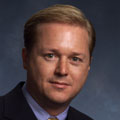Crossroads for Kodak
- 25 May 2006
 Jon Hoeksma
Jon Hoeksma
At the beginning of May Eastman Kodak Company announced that it was examining options for finding a partner to share its highly successful healthcare group or for divestment.
What does this mean for the group that has been in operation for over 100 years and had revenues of $2.7bn in 2005?
Speaking from Rochester, New York, Kevin Hobert, president of Kodak Health Group, told E-Health Insider why Kodak had taken the decision, and outlined how he believes the fast growing global health IT market will evolve over the next few years.
“The healthcare IT market is very, very hot at the moment and it’s a maturing market.” He added: "Overall our healthcare information business grew by 40% last year."
Hobert says that the key reason for Kodak looking at alternative options for its healthcare group is because it sees the global health IT market consolidating rapidly over the next four or five years.
Consolidation
He said that globally there were just a handful of full-capability players, with “hundreds and hundreds of specialist departmental system suppliers in each regional or country market”. But the key trend is towards far fewer and bigger players. “As a result of market growth what we are seeing is consolidation.”
And the Kodak Health boss says that the pace of consolidation in the industry is heating up. “We’ve already seen more deals this year than last.” Despite the increased number of deals, Hobert added that industry consolidation was still at a relatively early stage, and nobody yet had a broader market share across the wider healthcare IT space.
Although Kodak Health has a multi-billion dollar turnover, an international reach, and a leading position in markets such as radiology information systems and PACS, this only made it a top mid-tier player in the fast consolidating health IT and medical technology markets. Kodak Eastman’s stated policy is to seek to be the number one or two in the markets where competes.
Hobert told EHI that in Kodak’s analysis of the market over the next few years, thefocus had been on how many companies there would be and what kind they would be. “There are three big imaging companies and about six broad-based health IT companies. We’d like to be one of those.”
He added: “If you look out four or five years, if we are not aggressive today in forming alliances, or being acquired we are risking not being a leading player in the future.” Hobert added the advisers had been appointed, to help the company determine “what the best option is for us”.
However, he confirmed that Kodak Health had ruled out major acquisitions as a route to be a leading player. “We are not going to do a bunch of big acquisitions. We specced that out and that would take a bunch of money.”
Future strategy
Asked what Kodak’s preferred strategy was for its health business, Hobert said: “We’re more interested in partnership or divestiture to someone who can build on our strengths.”
Hobert added that the aim was to conclude arrangements for the future of the company as soon as possible as “announcements like this tend to create a lot of anxiety.” He confirmed that the company had already got a range of interest from a number of parties.
“We have a lot to bring to the table. We have a very strong brand and have been in the market for 110 years.”
“Kodak has global sales and services; we’ve great people and customer relationships.” He pointed to Kodak’s leadership in “proven scalable solutions for PACS, and information management solutions for CR and DR. What we have is a strong solution set to grow on. We think we’d make a very strong partner.”
The Kodak Health president said benefits of consolidation for customers would include one provider being able to offer and support a range of solutions and moving towards providing “a solution that is fully integrated”.
Software modules can be shared by different solutions, he said, and firms would be better able to offer facilities such as remote installation and support. “These are all components of the IT architecture of a mature industry,” said Hobert.
He added that Kodak had already delivered exactly these types of benefits in the US dental software market, “Where we built software and then bought competitor firms and then integrated all our customers to one solution, with one service centre and call centre”. Hobert said this had provided Kodak with efficiencies of scale, one fixed infrastructure and improved service levels. “We see the same kind of thing happening in the healthcare IT field”.
US market
In its home US market, Hobert says Kodak is seeing a lot of activity, and is seeing "more and more and RHIO [Regional Health Information Organisation] activity, some of which we are leading."
“We’re seeing more and more large infrastructure and IT deals where government is getting involved.” He added that so far these projects were "nothing as far advanced yet as the progress you can see in parts of Europe".
Turning to the UK, he said: "We’re very pleased with our position in the UK market, we’re participating in a couple of the National Programme for IT clusters, working with NHS Scotland and just done a PACS deal with BUPA. The UK is a very important market for us."
Kodak Health is also currently involved in large health IT PACS and digital radiology programmes elsewhere in Europe, including France, Finland and Italy. "In France we’ve just completed phase one of the APHAP [Assistance Publique – Hopitaux de Paris] programme, in which we’ve digitised imaging in 26 public hospitals."
"We’ve also just done a deal in Estonia," added Hobert. "We’ve had a lot of success across the public and private sectors." The clear trend he said was from small scale to multi-site implementations, but with growth also occurring in the lower end of the market in smaller clinics.
Hobert said that the rapid consolidation occurring in the European health IT market was also occurring in the US. "A lot of trends are very similar in the US market, with consolidation of the market."
He said that key conditions are now in place in Europe and the US for further rapid growth. Hobart said these include necessary investments in infrastructure together with the development of standards.
Hobert pointed out that the development of accepted industry standards for diagnostic images had been a spur to rapid growth in the digital diagnostic imaging market.
“Customers need to get an EPR, a patient-centric IT system, that will support integrated high quality care. What we need to do is to offer more of the pieces, with an integrated company or partnerships."




